|
Historical Information

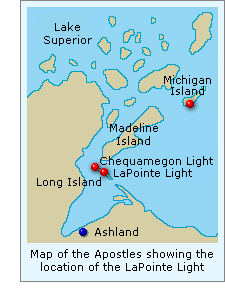 By the last decade of the nineteenth century, it became clear
that the diminutive 34-foot tall tower of the 1858 LaPointe light was no
longer serving the needs of maritime traffic passing between Madeline,
Stockton and Michigan Island. Located too far to the west, it was
obscured by the southern tip of Madeline Island until vessels were
almost on top of it. In 1890 the Lighthouse Board proposed that $7,500
be appropriated to replace the old light with a new 70-foot tall iron
tower to be located next to the fog signal building which had been
constructed ¾ of a mile to the east of the old light in 1891.
By the last decade of the nineteenth century, it became clear
that the diminutive 34-foot tall tower of the 1858 LaPointe light was no
longer serving the needs of maritime traffic passing between Madeline,
Stockton and Michigan Island. Located too far to the west, it was
obscured by the southern tip of Madeline Island until vessels were
almost on top of it. In 1890 the Lighthouse Board proposed that $7,500
be appropriated to replace the old light with a new 70-foot tall iron
tower to be located next to the fog signal building which had been
constructed ¾ of a mile to the east of the old light in 1891.
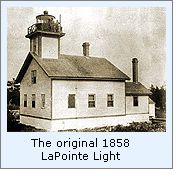 Since this new light would be located
over a mile from the northwestern tip of Long Island, it was
simultaneously proposed that a small light and fog bell be constructed
on Chequamegon Point at the northwestern tip of the island to mark the full extremity of the
south shore of the passage leading to Ashland at the south end of
Chequamegon Bay. Estimating that the erection of an iron beacon typical of
those installed on pier heads around the lakes would allow the structure
to be built for $2,500, the Board requested a total appropriation
of $10,000 for the full improvements at Long Island. Congress was slow
to respond, and the Board reiterated its request in each of its annual
reports for the following four years until Congress finally responded
favorably with the requested appropriation on March 2, 1895. Since this new light would be located
over a mile from the northwestern tip of Long Island, it was
simultaneously proposed that a small light and fog bell be constructed
on Chequamegon Point at the northwestern tip of the island to mark the full extremity of the
south shore of the passage leading to Ashland at the south end of
Chequamegon Bay. Estimating that the erection of an iron beacon typical of
those installed on pier heads around the lakes would allow the structure
to be built for $2,500, the Board requested a total appropriation
of $10,000 for the full improvements at Long Island. Congress was slow
to respond, and the Board reiterated its request in each of its annual
reports for the following four years until Congress finally responded
favorably with the requested appropriation on March 2, 1895.
On receipt of the appropriation, the
Eleventh District Inspector immediately began negotiations for the
purchase of a two sites on the island. One for the new main light some
3,000 feet to the east of the existing station near the fog signal
building and the other at Chequamegon Point for the construction of the
small tower and fog bell to mark the point itself. However, with the
letting of contracts for the fabrication and delivery of the iron work
for both new structures, it quickly became clear the $10,000
appropriation was insufficient for the task, and an additional $1,500
appropriation was requested.
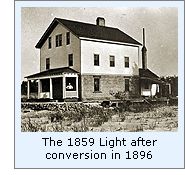 Since the LaPointe keepers would soon
be responsible for two lights and a fog signal, it was also determined
that a full-time assistant keeper would need to be assigned to the
station to keep up with the workload, and thus additional living
quarters would need to added. In an attempt to keep costs within the
appropriated amount, it was decided to convert the existing LaPointe
lighthouse into a duplex dwelling, since with the construction of the
two new lights the old structure would otherwise no longer serve any
purpose. To this end, the 1858 LaPointe lighthouse was jacked-up in the
summer of 1896, and a brick basement constructed beneath and the
interior of the structure reconfigured to accommodate two keepers.
Amazingly, the light atop the roof was kept in operation throughout the
entire reconstruction, and thus the expense of building a temporary
tower was also avoided. Since the LaPointe keepers would soon
be responsible for two lights and a fog signal, it was also determined
that a full-time assistant keeper would need to be assigned to the
station to keep up with the workload, and thus additional living
quarters would need to added. In an attempt to keep costs within the
appropriated amount, it was decided to convert the existing LaPointe
lighthouse into a duplex dwelling, since with the construction of the
two new lights the old structure would otherwise no longer serve any
purpose. To this end, the 1858 LaPointe lighthouse was jacked-up in the
summer of 1896, and a brick basement constructed beneath and the
interior of the structure reconfigured to accommodate two keepers.
Amazingly, the light atop the roof was kept in operation throughout the
entire reconstruction, and thus the expense of building a temporary
tower was also avoided.
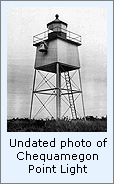 Four concrete anchoring pads were cast
in place at Chequamegon Point, and the skeleton iron tower was erected
to the point at which it was ready to receive the light. However, with
the appropriated funds exhausted, work was discontinued on both towers
on October 3, 1896 to await additional funding. Congress appropriated
the additional $1,500 on July 14, 1897, and the AMARANTH returned to
Long Island with a work crew soon thereafter, with work assuming a
feverish pace throughout the 1897 season of navigation. Four concrete anchoring pads were cast
in place at Chequamegon Point, and the skeleton iron tower was erected
to the point at which it was ready to receive the light. However, with
the appropriated funds exhausted, work was discontinued on both towers
on October 3, 1896 to await additional funding. Congress appropriated
the additional $1,500 on July 14, 1897, and the AMARANTH returned to
Long Island with a work crew soon thereafter, with work assuming a
feverish pace throughout the 1897 season of navigation.
With the completion of Chequamegon
Point tower, the fixed red Fourth Order lens was removed from the old
LaPointe Light and reinstalled in the new tower's lantern on the night
of October 11, 1897 without any change in characteristic. Consisting of
a white square pyramidal skeleton iron tower surmounted by a square
watchroom and octagonal black lantern, a fog bell was suspended from an
exterior wall of the watchroom, and operated by a Stevens
fog
bell apparatus housed within the watchroom. A connecting rod attached
the apparatus to a hammer which struck the bell once every 20 seconds
through an aperture in the wall. Standing 39 feet from the base to the
top of the ventilator ball, the light stood with a focal plane of 42
feet and was visible for a distance of 16 miles in clear weather.
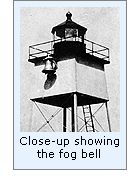 The LaPointe keepers were now required
to walk the mile and a quarter distance between the main LaPointe Light and
Chequamegon Point numerous times each day to tend the light and fog bell
on the point. To male this walk both easier and safer, large pre-cast concrete blocks
with steel reinforcement rods were shipped from the
Detroit depot to Long Island in 1903, and installed along the dune ridge
running along the center of the island to connect both lights. The LaPointe keepers were now required
to walk the mile and a quarter distance between the main LaPointe Light and
Chequamegon Point numerous times each day to tend the light and fog bell
on the point. To male this walk both easier and safer, large pre-cast concrete blocks
with steel reinforcement rods were shipped from the
Detroit depot to Long Island in 1903, and installed along the dune ridge
running along the center of the island to connect both lights.
By
1911, the shore at Chequamegon Point was becoming significantly eroded
by wave action, and fearing that the small iron tower might be
undermined and topple, a work crew was dispatched to Long Island to
construct three 32-foot long log cribs, which were placed along the
northwest side of the point and filled with crushed stone and planked
over to serve as a protection for the shore, and stem the erosion.
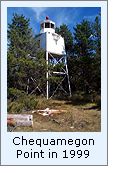 Little changed at the Chequamegon Point
Light over the years until both it and the LaPointe Light were fully
automated in 1964, and the final crew of Coast Guardsmen to man the
station departed. Responsibility for maintenance of the structures was
thus transferred to the crew
at the Devils Island Light, which remained manned to serve all of the
Apostle Islands lights until 1878. Little changed at the Chequamegon Point
Light over the years until both it and the LaPointe Light were fully
automated in 1964, and the final crew of Coast Guardsmen to man the
station departed. Responsibility for maintenance of the structures was
thus transferred to the crew
at the Devils Island Light, which remained manned to serve all of the
Apostle Islands lights until 1878.
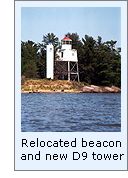 Although the formation of the Apostles
Island National Lakeshore on September 26, 1970 assured the long-term
survival of the remaining Apostle Islands lighthouses, Long Island was
not included as part of the National Lakeshore until 1986, when the Park
boundaries were expanded to include Long Island and Congress passed
legislation transferring all lands within the Apostle Islands National
Lakeshore Park boundaries over to the NPS. Thus, in a single stroke of the
pen all of the Coast Guard properties within the park were
simultaneously transferred into NPS ownership. Although the formation of the Apostles
Island National Lakeshore on September 26, 1970 assured the long-term
survival of the remaining Apostle Islands lighthouses, Long Island was
not included as part of the National Lakeshore until 1986, when the Park
boundaries were expanded to include Long Island and Congress passed
legislation transferring all lands within the Apostle Islands National
Lakeshore Park boundaries over to the NPS. Thus, in a single stroke of the
pen all of the Coast Guard properties within the park were
simultaneously transferred into NPS ownership.
With wave action threatening to undermine the
foundation of the Chequamegon Point tower in 1987, the
structure was suspended beneath a Coast Guard helicopter and dragged
back from the eroding shoreline to its present position. At this time,
an ignominious "D9" tower was erected close to the shore and
equipped with a green 12 volt solar powered 300 mm acrylic
optic, which
continues to light Chequamegon Point to this day.

Keepers of
this Light

Click here
to see a complete listing of all LaPointe Light keepers compiled by
Phyllis L. Tag of Great Lakes Lighthouse Research.

Seeing this Light

For five
days in July, 2002, we were privileged to serve as NPS volunteers,
assisting Park Historian Bob Mackreth in documenting the condition of
all the Apostle Islands Lights, and visited Long Island in a Boston
Whaler on the afternoon of our first day in the Apostles after spending
the morning on Outer Island.
It was 95 degrees that
day, and the walk out along the ridge to see the ruins of the old
LaPointe Light was difficult going since all remnants of the 1903
concrete pathway were buried beneath the sand and the path was overgrown
by stubby evergreens.
After photographing the
ruins of the old dwelling, we were somewhat overheated, and with our
time on the island almost over, we made our way back to the dock, and
took the Whaler out around Chequamegon Point to photograph the light
from offshore.

Finding this Light

 At
this time, the LaPointe and Chequamegon Point Lights are the only
lighthouses in the Apostles which are not open to the public on a regular
basis during the summer. However, the island itself
is open to the public, and good views of the exteriors of the tower and
dwelling can be obtained. At
this time, the LaPointe and Chequamegon Point Lights are the only
lighthouses in the Apostles which are not open to the public on a regular
basis during the summer. However, the island itself
is open to the public, and good views of the exteriors of the tower and
dwelling can be obtained.
Thus, a private boat is needed to make landfall on
Long Island for all but two weeks of the year when Apostle
Island Cruise Service offers landing trips to the island during the two
weeks of the annual Keeper of The Light festival in September.

Contact information

Apostle Island Cruise Services
P.O. Box 691 - City
Dock
Bayfield, WI 54814
Telephone: (800) 323-7619
Email: info@apostleisland.com
For information on the Keeper
Of The Light Celebration, contact:
PO Box 990 19 Front St.
Bayfield, WI 54814
Telephone: (800) 779-4487

Historical
references

Annual reports of the lighthouse Board, various, 1890 - 1909
Annual reports of the Lighthouse Service, various, 1910 - 1953
Great Lakes Light Lists, various, 1901 - 1977
Annual reports of the Lake Carrier's Association, various, 1906 -
1940
Personal observation made on Long Island during visit in July, 2002.
Recent photograph courtesy of NPS.
Historic photographs courtesy of the USCG and NPS historians offices.
Email correspondence with Bob Mackreth NPS, various, January &
February 2002
Keeper listings for this light appear
courtesy of Great
Lakes Lighthouse Research
|
